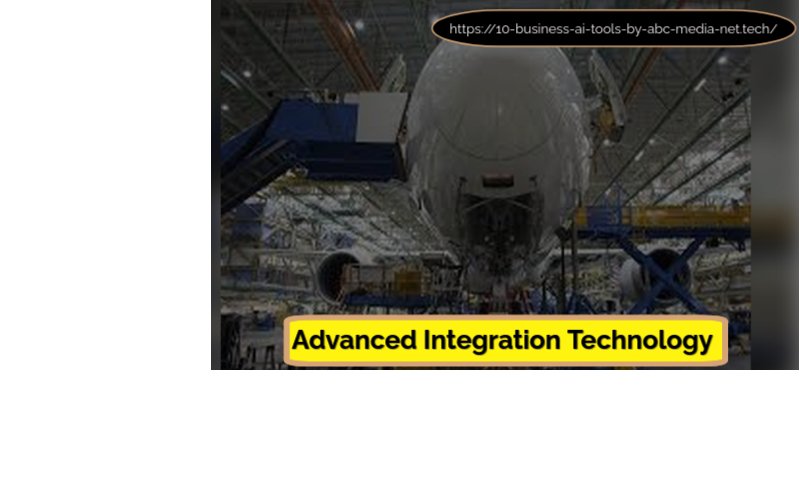Table of Contents
- Introduction
- What is Advanced Integration Technology?
- The Evolution of Integration Technology
- Key Components of Advanced Integration Technology
- Benefits of Advanced Integration Technology
- Use Cases of Advanced Integration Technology
- Challenges of Implementing Advanced Integration Technology
- The Role of AI and Machine Learning in Advanced Integration
- Best Practices for Implementing Advanced Integration Technology
- Future Trends in Advanced Integration Technology
- Conclusion
- FAQs
Introduction
Hey there! Today, I need to talk about some thing that’s in reality reshaping how agencies function: Advanced Integration Technology (AIT). So, what precisely is Advanced Integration Technology AIT? It’s all approximately connecting unique systems, packages, and data assets a good way to work together easily.
In our digital international, this kind of integration generation is notable vital for corporations that need to live competitive. I’ve seen firsthand how Advanced Integration Technology (AIT) facilitates corporations streamline their operations, increase collaboration, and make higher selections. By enabling actual-time information sharing and automation, Advanced Integration Technology( AIT) drives innovation and performance across diverse industries.

What is Advanced Integration Technology?
Let’s wreck it down a piece extra. When I speak approximately Advanced Integration Technology, I’m referring to a set of practices designed to unify special systems within an agency.
- Definition and Core Principles
At its middle, AIT focuses on some key ideas:
| Principle | Description |
|---|---|
| Interoperability | Making sure different systems can communicate effectively. |
| Scalability | Allowing systems to grow as the business expands. |
| Flexibility | AIT adapts to changing requirements quickly. |
- Interoperability: Making positive specific structures can talk efficiently.
- Scalability: Allowing systems to develop because the business expands.
- Flexibility: AIT adapts to changing requirements fast.
Key Features
Here are a few functions that I locate especially thrilling:

- Real-Time Data Sharing: You can get admission to facts right away across platforms.
- Automation: AIT reduces manual processes, which saves time and sources.
- AI-Driven Processing: This makes use of synthetic intelligence to make smarter decisions based on records.
Examples of Industries Where AIT is Crucial
I’ve noticed that AIT is specially impactful in various sectors:
| Industry | Impact of AIT |
|---|---|
| Manufacturing | Streamlines production processes. |
| Healthcare | Integrates electronic health records (EHR) for better patient care. |
| Finance | Automates transactions and makes data management much easier. |
- Manufacturing: It streamlines production processes.
- Healthcare: Integrating digital fitness data (EHR) results in higher patient care.
- Finance: Automating transactions makes facts control an awful lot easier.
The Evolution of Integration Technology
Now, allows take a brief experience down memory lane to see how integration era has developed over the years.
History and Traditional Integration Approaches
In the beyond, integration was regularly performed thru factor-to-factor connections or batch processing methods. These procedures had numerous downsides:
- Increased complexity in handling connections.
- Higher preservation charges due to more than one interfaces.
- Data silos that made it tough to access information.
Key Milestones in Evolution
The evolution of integration generation has seen a few extensive milestones:
| Milestone | Description |
|---|---|
| Early APIs | Allowed basic communication between systems. |
| Service-Oriented Architecture (SOA) | Enabled more flexible integrations. |
| Modern Integration Platforms | Offer comprehensive solutions that support various integration styles. |
- Early APIs: They allowed simple verbal exchange among structures.
- Service-Oriented Architecture (SOA): This made integrations greater bendy.
- Modern Integration Platforms: These platforms now provide comprehensive solutions that assist numerous integration styles.
Transformation of Business Processes
I can’t pressure sufficient how AIT has changed the way businesses function by using enhancing facts accessibility and enhancing responsiveness to marketplace modifications.
Key Components
Let’s dive into a few key additives of AIT that I assume are critical for any business enterprise looking to integrate their structures efficaciously.
Data Integration
Seamless data glide is crucial for making informed decisions. With AIT, you may assume:
- Centralized information repositories that permit easy access to records.
- Real-time updates across systems to maintain everyone knowledgeable.
Process Automation
Automating workflows means less guide intervention for me and my team. This leads to:
- Increased productivity as obligations get completed quicker.
- Reduced errors via automatic methods.
Cloud Integration
Connecting cloud-primarily based and on-premise systems permits corporations to:
- Use existing infrastructure while adopting new technology with out disruption.
AI and Machine Learning Integration
Integrating AI enhances selection-making via:
- Predictive analytics that provide insights based totally on historical statistics styles.
API Management
Efficient API control ensures better connectivity with the aid of:
- Streamlining the development and deployment of APIs throughout various structures.
Benefits of Advanced Integration Technology
Now allow’s speak approximately why AIT is so useful!
| Benefit | Percentage of Businesses Reporting Benefit (%) |
|---|---|
| Increased Efficiency | 85 |
| Improved Data Accuracy | 75 |
| Enhanced Scalability | 70 |
| Cost Reduction | 65 |
| Improved Collaboration | 80 |
| Enhanced Security | 90 |
Increased Efficiency
With AIT, I’ve seen agencies obtain quicker processing and actual-time records sharing, which ends in:
- Reduced operational delays.
- Quicker response instances to marketplace demands.
Improved Data Accuracy
Automated information syncing minimizes mistakes, resulting in:
- Higher best facts for analysis and reporting.
Enhanced Scalability
Organizations can develop with out good sized rework due to:
- Flexible integration solutions that adapt without difficulty to converting wishes.
Cost Reduction
Streamlining operations ends in decreased overhead costs by way of:
- Minimizing manual approaches and improving resource allocation.
Improved Collaboration
AIT enhances communication among departments with the aid of imparting a unified view of information throughout systems, fostering teamwork among my colleagues.
Enhanced Security
Advanced encryption and safety measures defend touchy statistics throughout integration procedures, which is constantly a top priority for me.
Use Cases of Advanced Integration Technology
Let me proportion a few actual-international use instances in which AIT shines!
Healthcare
In healthcare, integrating EHR with wearable devices lets in for actual-time affected person tracking. Hospitals can music affected person vitals routinely, lowering the need for guide tests.
Manufacturing
In production, connecting IoT gadgets with ERP systems allows predictive upkeep. According to a file by means of McKinsey, producers adopting IoT can reduce maintenance fees by up to 30%.
Finance
In finance, automating fee approaches whilst integrating with CRM structures offers real-time customer facts management, enhancing carrier shipping extensively.
E-trade
In e-trade, synchronizing stock and consumer data throughout systems creates a unified purchasing revel in that improves client delight degrees.
Challenges of Implementing Advanced Integration Technology
While AIT gives many advantages, there are challenges corporations face while imposing those technologies.
Legacy Systems
Integrating older systems with modern-day generation may be complex because of compatibility troubles. Many agencies nevertheless rely on old software program that does not without problems join with more recent platforms.
Security Risks
Ensuring records safety for the duration of integration is paramount as vulnerabilities may additionally arise at some point of the method. Companies should put into effect strong safety measures to shield touchy statistics from breaches.
Data Silos
Fragmented statistics across diverse systems can avoid powerful choice-making unless well incorporated. Organizations frequently struggle with gaining access to entire datasets important for complete evaluation.
Complexity
Managing distinctive technology and structures gives demanding situations that require skilled employees and robust techniques. The integration landscape is numerous, making it tough for teams without specialised expertise.
Cost of Implementation
Balancing the price as opposed to ROI when adopting AIT answers can be tough for organizations with restricted budgets. Initial investments in technology may appear excessive however can lead to lengthy-time period savings if implemented efficaciously.
The Role of AI and Machine Learning in Advanced Integration
AI enhances integration through enhancing records analytics thru:
- Real-time insights that inform strategic choices.
Machine mastering can create self-getting to know integration structures that adapt primarily based on usage patterns, in addition enhancing efficiency over time. This functionality lets in companies to respond dynamically to changing conditions or consumer behaviors.
Best Practices for Implementing Advanced Integration Technology
Here are some quality practices I advise for imposing AIT correctly:
- Plan and Strategize: Assess organizational needs and become aware of key structures for integration.
- Choose the Right Integration Platform: Consider scalability, protection functions, and ease of use.
- Ensure Data Governance: Protect touchy records thru regulated get entry to protocols.
- Test Before Full Implementation: Conduct small-scale exams to discover capability problems early on.
- Continuous Monitoring and Optimization: Regularly screen overall performance metrics and optimize for future upgrades.
Future Trends in Advanced Integration Technology
Let’s appearance at some interesting tendencies shaping the future of AIT!
Hyperautomation
The fashion closer to automating each possible technique will preserve as businesses are seeking more performance through AIT solutions. According to Gartner, hyperautomation will be a top precedence for 70% of large organizations by using 2024.
Hybrid Integration Platforms
Combining cloud-based totally services with on-premise structures gives flexibility for businesses trying to adapt speedy to marketplace changes. This method lets in agencies like mine to make use of current infrastructure whilst embracing new technology.
IoT and Edge Computing Integration
Expanding integration capabilities to the edge of networks will allow faster processing instances and stepped forward responsiveness in actual-time programs. This trend is specifically relevant as IoT devices proliferate in various sectors.
Blockchain for Secure Integrations
Utilizing blockchain generation will beautify the security of incorporated systems, providing immutable facts that shield towards fraud. As cybersecurity threats develop, blockchain gives a promising answer for protecting included environments.
Conclusion
Advanced Integration Technology plays a extensive position in present day business operations. Companies that undertake AIT are better positioned for increase as they are able to innovate quicker whilst enhancing efficiency. As generation continues to evolve, embracing superior integration answers will be key to destiny-proofing companies in an more and more aggressive landscape.
FAQs
- What is Advanced Integration Technology?
Advanced Integration Technology AIT refers to equipment and methods used to attach diverse structures seamlessly within an enterprise.
- How does AIT benefit groups?
It will increase performance, improves statistics accuracy, complements scalability, reduces prices, improves collaboration, and complements security.
- What industries advantage from AIT?
Industries like healthcare, production, finance, and e-commerce see significant advantages from implementing AIT solutions.
- What are a few challenges confronted when imposing AIT?
Challenges include integrating legacy structures, coping with security risks, overcoming information silos, dealing with complexity, and balancing prices as opposed to ROI.
- How does AI play a role in advanced integration?
AI complements integration through supplying actual-time insights thru predictive analytics and permitting self-studying competencies inside integration structures.







2 thoughts on “Advanced Integration Technology: Driving Innovation and Efficiency”